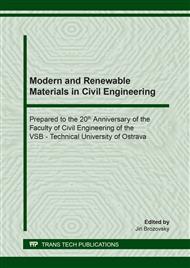p.3
p.11
p.21
p.29
p.41
p.51
p.63
p.73
Experimental Research on the Properties of Secondary Raw Materials Resulting from the Recycling of Tyres
Abstract:
The paper deals with the research on the properties of secondary raw materials resulting from the recycling of used tyres and their potential utilization for the production of construction insulations. Evaluation of the possibilities of utilization and a complex analysis has been executed on the basis of the defined basic physical, thermal-insulating and fire properties of the raw textile fibres examined. The results of the research on the material examined indicate possible exploitation of this potential material for the construction of environmentally-friendly objects. Thermal insulating parameters have been determined by the value of thermal conductivity coefficient λ. For measuring of thermal conductivity coefficient of fibres has been used the special laboratory device – the Cooling Box. Physical properties have been determined by microscopic examination and by laboratory measuring of fibres length, diameter, pour bulk and compressed bulk densities. Fire characteristics were determined during several fire tests of textile fibres. On the basis of performed fire test has been determined the combustion heat, flash point (FIT) and ignition temperature (SIT).
Info:
Periodical:
Pages:
29-38
Citation:
Online since:
February 2020
Authors:
Keywords:
Price:
Сopyright:
© 2020 Trans Tech Publications Ltd. All Rights Reserved
Share:
Citation:


